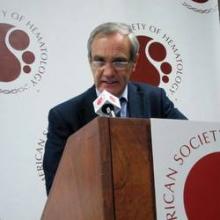ATLANTA – Cytotoxic chemotherapy is not needed to achieve excellent results in the first-line treatment of acute promyelocytic leukemia, a most aggressive form of acute leukemia.
A phase III trial achieved a 2-year event-free survival rate of 86.7% with all-trans retinoic acid (ATRA) and chemotherapy, the current standard, and 97% with ATRA plus arsenic trioxide (ATO), a small-molecule arsenic compound (P = .03).
The new chemotherapy-free regimen represents "the demolition of a dogma" by showing that cancer is not an irreversible condition and that malignant cells can be transformed rather than killed with chemotherapy, Dr. Francesco Lo-Coco said at a press briefing during the annual meeting of the American Society of Hematology.
ASH president Armand Keating said that the groundbreaking study highlights novel approaches – in this case a targeted combination with roots in ancient Chinese medicine – that can produce comparable efficacy with far less toxicity than chemotherapy.
"This, I think, is an exciting development because it is a shift in the way we think of treating potentially fatal diseases, quite remarkable," Dr. Keating said during a teleconference with reporters.
He pointed out that, 30-40 years ago, before ATRA and chemotherapy transformed the treatment of acute promyelocytic leukemia (APL), mortality was 100%, with most patients dying within a week.
ATRA and cytotoxic chemotherapy, typically containing anthracyclines, produce remission rates of 85%-90% in APL, but early death and relapse among high-risk groups such as the elderly remain problematic in the management of APL.
"I found this study amazing, frankly. ... This [disease] used to be the worst of the worst," ASH Secretary Charles Abrahms said during the teleconference.
Both men remarked that the results will spur further research to elucidate how ATO works, not just in APL but in other diseases.
The current trial is the first randomized, prospective phase III trial to compare ATRA plus ATO against the standard of care, although earlier phase II trials have reported encouraging responses to ATO in combination with other drugs.
As for how the combination works, the altered protein present in APL has specific binding sites for ATO and ATRA, explained Dr. Lo-Coco of the University of Tor Vergata, Rome. ATRA, a derivative developed from Chinese herbal medicine, is thought to induce leukemia cell differentiation, whereas ATO, well known for its activity in treating relapsed APL, produces remissions at least in part by inducing apoptosis.
Dr. Lo-Coco and his coinvestigators in Italy and Germany enrolled 162 patients with newly diagnosed, non–high-risk APL; the median age was 45 years (range 18-70) and the median white blood cell count was 1.50 × 109/L.
Patients in the experimental arm received arsenic trioxide 0.15/kg plus oral ATRA 45 mg/m2 daily until complete remission, then ATO given 5 days per week, 4 weeks on and 4 weeks off, for a total of four courses and ATRA given 2 weeks on and 2 weeks off for a total of seven courses. Patients in the control arm received standard ATRA plus 12 mg/m2 idarubicin as induction, followed by three cycles of anthracycline-based chemotherapy plus ATRA consolidation and maintenance with low-dose chemotherapy and ATRA.
Of the 154 patients evaluable for response to induction, all 75 patients in the experimental arm and 75 of 79 in the control arm achieved complete remission, Dr. Lo-Coco reported in the plenary session.
Molecular complete remission per central review was seen in 141 of 142 evaluable patients after completing the third round of consolidation therapy.
After a median follow-up of 31 months, overall survival was 98.7% with ATRA plus ATO and 91.1% with ATRA plus chemotherapy (P = .02), he said.
Patients receiving ATRA and chemotherapy had significantly more episodes of fever lasting more than 15 days and grade 3 or higher neutropenia and thrombocytopenia than those receiving ATRA and ATO (P less than .001 for all differences).
The ATRA/ATO combination, however, induced QTc prolongation in two patients, requiring ATO discontinuation and study withdrawal for one of them, Dr. Lo-Coco reported.
Rates of APL differentiation syndrome and increased liver enzymes were similar in both groups. There was one death and two relapses in the experimental arm vs. seven deaths and four relapses in the control arm.
The success achieved with ATRA and ATO therapy is likely to raise new questions regarding use of ATO monotherapy in the first-line treatment of APL. The first study to take this approach reported a complete remission rate of 86% in treatment-naive patients (J. Clin. Oncol. 2011;29:2753-7), but the phase II study conducted in Iran prompted a backlash of criticism that it violated medical ethics by failing to provide standard treatment. An accompanying editorial, however, pointed out that treatment with ATRA, anthracyclines, and cytarabine is often "prohibitively expensive in the developing world" (J. Clin. Oncol. 2011;29:2743-6)


